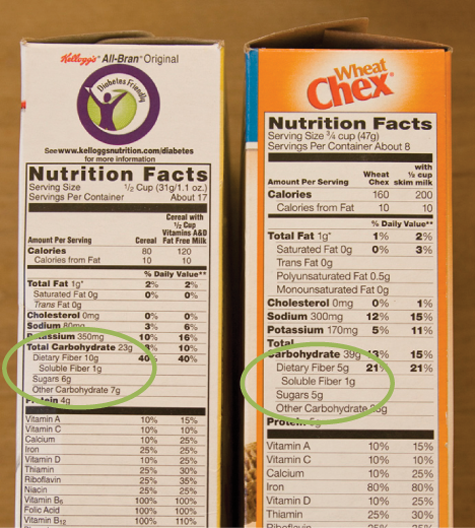
The quick answer: Breakfast is the easiest meal to make healthy. Just remember one rule: More natural fiber than added sugar.
_________________________________________________________________________________________________
There’s a timeless rhythm to our eating: breakfast, lunch, then dinner, plus a snack or two in between. Occasional fasting provides health benefits, but skipping meals or eating irregularly doesn’t. The meal most skipped is breakfast, the subject of this post. You heard it from your mom, but we’ll say it one more time: A good breakfast gives you energy for your daily work. There’s one more benefit to eating regularly: You’re less susceptible to craving sugary, unhealthy snacks due to fading energy.
Sugar bad; fiber good
In the modern diet of refined foods we eat way too much added sugar, and too little natural fiber. Because the MAD diet is a scary bad risk factor for the chronic diseases, Science has provided sugar and fiber guidelines: Refined sugar has a maximum limit, while fiber has a minimum requirement.
Sugar: The American Heart Association says added sugar intake shouldn’t exceed 100 calories daily, or 6 tsp (26 grams) for women or 150 calories, 9 tsp (39 grams), for men. (Don’t worry about the natural sugars in fruit—Nature delivers them with protective nutrients.)
Fiber: The Institute of Medicine recommends 14 grams daily per 1000 dietary calories. Per the NHANES data, the average woman eats 1833 calories, while men consume 2475 calories. So our fiber goal is 26 grams for women, and 35 grams for men. Basically we should reverse our diet to eat more fiber than sugar.
A Simple Rule: Counting your daily grams of sugar and fiber is crazy hard so Word of Wisdom Living offers a simple rule: Processed foods—the bulk of the MAD diet—should have more fiber than sugar. This follows the guidance given above. It’s easy to check because processed foods are required to show the grams of sugar and total fiber on the nutrition facts panel.
Applying the Fiber>Sugar Rule
We visited the breakfast cereal aisle of a local supermarket and checked every cereal against the fiber>sugar rule. (That little horizontal “v” means, ‘greater than’.) The results were reported in the post, Trouble In The Cereal Aisle. Bottom line: Of 128 packaged cereals only 13 met this healthy rule. In other words, 90% of those over-priced breakfast cereals don’t meet basic health rules. This is a food disaster.

Here are some cereals that met the rule: old-fashioned Shredded Wheat (no white sugar coating); Post Grape Nuts; and Kellogg’s All Bran. Regular oatmeal has no sugar added so is a great breakfast dish.
We also applied the Fiber>Sugar Rule to the bread aisle in the post, Waking Up In The Bread Aisle, with similar results. We didn’t bother with the cookie aisle—the stuff is terrible and doesn't really taste good.
A Better Breakfast
It goes against one’s sense of thrift that packaged cereals contain ingredients costing pennies per pound but are sold in stores for dollars per pound. It’s both cheaper and healthier to cook a breakfast of whole grains. So we developed a recipe called the Breakfast Compote based on whole grains sweetened with fruit; you can see the recipe here. Its as healthy as a breakfast can be—we eat it five days a week by varying the ingredients.
Worried that a breakfast so healthy is too costly? I got a scale and calculated the cost of ingredients for my Breakfast Compote—it’s way cheaper than the unhealthy stuff in the cereal aisle. So one more time: It really is cheaper to eat healthy, if you use natural foods and are willing to cook.
There’s a seasonal rotation to the fruits we use: strawberries in the spring, peaches in the summer, pears in the fall, and apples in winter. (Actually, spring strawberries showed up last week in our farmers’ market.) You can have blueberries year around by buying in bulk and keeping them in the freezer. They pour out like marbles but thaw quickly. I’ve made two other changes: we’ve gotten good results by increasing the ground flaxseed from 1 tsp to 2 tablespoons, and we add Katie’s Granola, recipe below, to improve texture and flavor. We eat the Breakfast Compote five days a week; I put a little milk on mine but the beautiful wife prefers fresh orange juice.
If your husband won’t get up and cook for you, try the Swiss breakfast of Muesli. (Yes, the beautiful wife is half-Swiss.) Available in health food stores, it’s basically oats with dried fruits and nuts. My brother-in-law makes a fruit smoothie for breakfast. My fancy sister makes oatmeal once a week and saves it in the fridge using a bread pan for easy serving. You can also make granola. We use the recipe called Katie’s Granola, found here.
A New Friend
Katrina Jones writes a blog—Katrina’s Kitchen—that I like. Check out her recipes for healthy breakfast treats, like Blueberry Muffins (whole wheat flour, just a little honey, no sugar); Homemade Granola; or something I’d never heard of, Carrot Pancakes. We find very few blog that focus on healthy eating as we understand it, but Katrina seems to get it.
Healthy Change

Please comment: Share your healthy breakfast ideas, your recipes, or your timesaving tips.
Need a reminder? Download our Healthy Change reminder card. Print and fold, then place in your kitchen or on your bathroom mirror to help you remember the Healthy Change of the week.